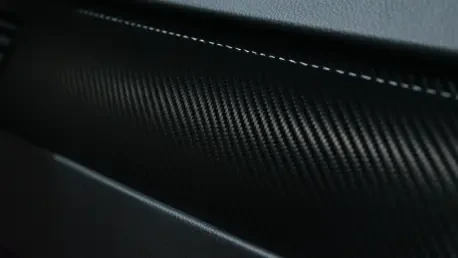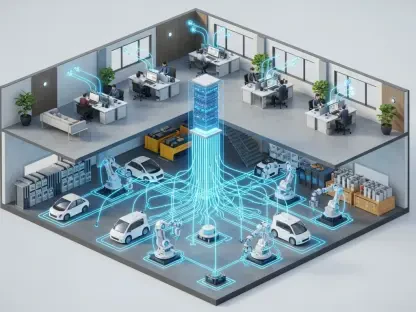In a world where digital connectivity underpins nearly every aspect of daily life, from business operations to personal interactions, a remarkable innovation is poised to redefine the future of data transmission with groundbreaking potential. Hollow core fibers (HCFs), a cutting-edge development in fiber optic technology, have emerged as a potential game-changer, thanks to pioneering work by researchers at the University of Southampton in collaboration with Microsoft. Achieving a record-low attenuation rate of 0.091 decibels per kilometer (dB/km), these fibers surpass traditional silica-core cables by an impressive 45%, offering a glimpse into faster, more efficient global networks. As the demand for high-speed internet and data-intensive applications continues to soar, this breakthrough addresses critical bottlenecks in current infrastructure, sparking excitement across the tech industry. The promise of HCFs lies not just in speed but in their capacity to reshape how information travels across continents, setting the stage for a new era of communication.
Understanding Hollow Core Fibers
The Technology Behind the Innovation
Hollow core fibers represent a radical departure from the conventional fiber optic cables that have been the backbone of global communications since the 1980s. Unlike traditional silica-core fibers, where light travels through a solid glass medium, HCFs utilize air as the primary conduit for light transmission. This fundamental shift capitalizes on the fact that light moves faster through air than through solid materials, potentially unlocking unprecedented data speeds. The design, refined by the University of Southampton team, incorporates a sophisticated microstructured glass sheath that encases the air core, minimizing signal leakage and ensuring stability over distance. This innovative approach marks a significant leap forward, as it tackles the inherent limitations of silica-based cables that have constrained network efficiency despite advancements in surrounding technologies. The result is a fiber optic solution that could redefine the parameters of data transfer, pushing the boundaries of what modern networks can achieve.
Another critical aspect of this technology is the precision required to maintain signal integrity within the air core. The challenge lies in preventing light from scattering or diffusing as it travels, a problem that early HCF prototypes struggled to overcome. The recent breakthrough at Southampton addressed this through meticulous engineering of the glass sheath, which acts as a barrier to contain and guide the light effectively. This advancement not only enhances transmission speed but also reduces energy loss, making HCFs a more sustainable option for future networks. By achieving an attenuation rate of 0.091 dB/km over a 9.3-mile distance, the technology demonstrates its readiness for real-world testing, though scaling it for widespread use remains a complex endeavor. This balance of innovation and practicality underscores the potential of HCFs to become a cornerstone of next-generation communication systems, provided further refinements continue to build on this foundation.
Breakthrough Performance Metrics
The standout achievement of hollow core fibers lies in their record-breaking performance, particularly the attenuation rate of 0.091 dB/km, which signals a 45% improvement over the standard 0.14 dB/km of silica-core fibers. Attenuation, a measure of signal loss over distance, has long been a limiting factor in fiber optic networks, dictating how far data can travel before requiring amplification. This dramatic reduction means that HCFs can transmit data over longer distances with less degradation, a crucial advantage for global communication lines spanning oceans and continents. Such efficiency could translate into fewer repeaters and lower operational costs for network providers, while also enhancing the quality of connections for end users. The implications of this metric extend beyond technical specifications, hinting at a future where data-intensive applications operate with unprecedented reliability and speed.
Beyond the headline attenuation figure, the performance of HCFs suggests a broader shift in how network infrastructure might evolve. Researchers remain optimistic that with continued development, attenuation could drop even further, potentially below 0.01 dB/km in the coming years. This ambition reflects a commitment to pushing the limits of fiber optic technology to meet the escalating demands of a hyper-connected world. Unlike silica-core fibers, which have reached near-optimal performance after decades of refinement, HCFs offer a fresh canvas for innovation, with room for significant gains. The Southampton team’s success over a 9.3-mile test distance serves as a proof of concept, validating the technology’s potential for specific high-value applications even if universal adoption is still on the horizon. This milestone provides a compelling case for increased investment and research, as the industry grapples with how to harness this capability effectively.
Challenges Facing Adoption
Practical Barriers to Implementation
While the potential of hollow core fibers is undeniable, their path to widespread use is fraught with substantial obstacles, particularly in terms of technical and logistical feasibility. One of the primary concerns is the fragility of HCFs compared to their silica-core counterparts, which have been engineered over decades to withstand harsh environmental conditions. The delicate nature of the microstructured glass sheath raises questions about durability, especially for installations in challenging terrains or underwater settings. Additionally, the production costs of HCFs remain prohibitively high due to the complexity of their design and the precision required in manufacturing. Replacing or even integrating these fibers into the existing global network infrastructure poses a monumental challenge, as it would require extensive modifications to current systems, from cable layouts to compatible hardware. These barriers highlight the gap between theoretical promise and practical deployment, tempering enthusiasm with a dose of realism.
Another layer of difficulty lies in the sheer scale of transitioning to a new fiber optic paradigm. The current infrastructure, built on silica-core technology, spans millions of miles across the globe, including vast undersea cables that connect continents. Overhauling this network to accommodate HCFs would demand not only financial investment but also coordinated international efforts to ensure compatibility and continuity of service. Retrofitting existing systems or laying new cables involves navigating regulatory hurdles, environmental concerns, and the risk of service disruptions during the transition. Moreover, the specialized equipment needed to install and maintain HCFs adds to the complexity, as does the need for skilled technicians trained in handling this novel technology. Until these logistical and economic challenges are addressed, the adoption of HCFs is likely to remain limited to experimental or niche deployments, despite their transformative potential for the future of connectivity.
Current Limitations
Beyond the practical barriers, hollow core fibers face inherent performance limitations that must be resolved before they can compete with or replace traditional cables on a large scale. Early iterations of HCFs suffered from significant signal loss over extended distances, a problem that, while mitigated in recent designs, has not been entirely eliminated. This issue of attenuation, though improved to 0.091 dB/km, still requires further optimization to ensure consistent performance across the vast spans typical of global networks. Additionally, the technology struggles with maintaining signal quality under varying environmental conditions, such as temperature fluctuations or physical stress, which could compromise reliability in real-world applications. These technical shortcomings underscore the reality that HCFs are still in a developmental phase, far from being a plug-and-play solution for the industry’s needs.
The timeline for overcoming these limitations also presents a significant hurdle, as research and testing continue to demand substantial time and resources. Experts anticipate that even with accelerated progress, widespread implementation of HCFs could take well over a decade, starting from now through at least 2035. During this period, silica-core fibers are expected to remain dominant, supported by incremental improvements in amplification and multiplexing technologies that extend their utility. The gradual nature of this transition suggests that HCFs might initially be deployed in controlled, high-priority settings where their benefits outweigh the risks and costs. This phased approach, while pragmatic, limits the immediate impact of the technology on global communications, necessitating patience and sustained investment. Bridging the gap between current capabilities and the vision of a fully HCF-based network remains a critical focus for researchers and industry stakeholders alike.
Future Potential and Implications
Emerging Trends and Expert Consensus
As the digital landscape continues to evolve, the push for more efficient data transmission solutions has never been more urgent, and hollow core fibers stand at the forefront of this transformation. The exponential growth in data consumption, driven by cloud computing, streaming services, and the Internet of Things, has exposed the limitations of existing silica-core infrastructure, creating a fertile ground for alternatives like HCFs. Experts across the field express cautious optimism about the technology’s trajectory, acknowledging that while it is not yet poised for mass adoption, its long-term potential is immense. The consensus leans toward a gradual rollout, with initial applications likely targeting latency-sensitive, long-distance connections where the speed and efficiency of HCFs can deliver immediate value. This strategic focus reflects a broader trend in the industry toward innovation that balances ambition with practicality, ensuring that new solutions are tested and proven before widespread integration.
This measured approach is further shaped by the recognition that technological revolutions in communications often unfold over decades rather than years. Historical shifts, such as the transition from copper to fiber optics, demonstrate the importance of incremental progress and stakeholder alignment in achieving lasting change. For HCFs, this means building on current achievements, like the 0.091 dB/km attenuation rate, to refine performance and address scalability concerns. Industry leaders and academics alike predict that over the next ten to fifteen years, starting from now, specialized deployments in sectors like finance or defense—where split-second data transfers are critical—could serve as proving grounds. Such targeted implementations would provide valuable data on real-world performance, informing broader strategies for adoption. The emerging consensus is clear: HCFs represent a pivotal step forward, but their journey to becoming a mainstream solution will require patience, collaboration, and continuous innovation.
Broader Societal Benefits
Looking to the horizon, the societal implications of hollow core fibers extend far beyond technical upgrades, promising to redefine how communities and economies interact in a hyper-connected world. If fully realized, this technology could support the seamless operation of data-intensive applications, from real-time global collaboration tools to advanced artificial intelligence systems that rely on massive data flows. Enhanced network efficiency and speed would enable more equitable access to digital resources, potentially bridging connectivity gaps in underserved regions where current infrastructure struggles to meet demand. By reducing signal loss and the need for frequent amplification, HCFs could also lower the energy footprint of communication networks, aligning with global sustainability goals. The ripple effects of such advancements touch on education, healthcare, and commerce, where faster, more reliable internet can drive innovation and improve quality of life.
Moreover, the adoption of HCFs could catalyze new paradigms in how data shapes international relations and economic competition. Nations and corporations investing early in this technology might gain strategic advantages in sectors dependent on cutting-edge connectivity, such as fintech or autonomous systems. However, realizing these benefits hinges on overcoming the current barriers of cost and implementation, ensuring that the technology does not remain confined to elite or niche markets. Collaborative efforts between governments, private entities, and research institutions will be essential to democratize access and scale solutions effectively. As research progresses over the coming decades, the vision of a world underpinned by HCF-driven networks grows more tangible, offering a future where the speed of light in air translates into the speed of human progress. This potential, while still distant, provides a compelling incentive to push the boundaries of what communication technology can achieve.









